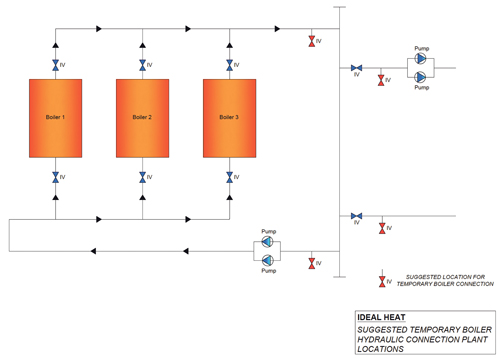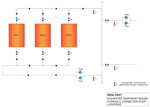Traditionally, designers have not considered what happens if it all goes wrong. The concept that maintenance should happen as a matter of course and that maintenance will be preventative is often overlooked. The fact is, most companies only buy reactive maintenance, either through lack of knowledge or money, this can mean, when something goes wrong it is catastrophic.
As designers, our contribution to disaster planning is usually, ‘a twin head pump and a standby boiler is enough’, but what if the issue is more serious? Few designers analyse the single point failure elements to their design and even if they did, clients would be unwilling to pay for a more robust solution.
 So what is the solution?
So what is the solution?
Designers should consider the provision for temporary boiler plant at the onset of their design. All that is required is a series of simple capped connection points for plant. These connection points will cost pence in initial installation and should the worst happen, the recovery strategy would not require new welded connections and hence could be delivered in hours and not days.
Temporary boiler companies can supply plant extremely fast, but precious time is lost because the plant room has no spare power provision or the system requires a tapping… or worse, the system needs a total plant room.
Every designer or system operator should consider a single point failure study, just to determine what may happen should something fail. Even if they do, we would recommend designing in a single connection point on the primary network and on each secondary network. Tackling primary and secondary enables parts of the system to be kept running if major changes to the primary network are needed. These connections should be line size with a valve and an end cap, they can also be used as a flushing or testing point in the future. Power provision should be provided ideally by way of commando plugs; a small temporary water supply will also be needed.
More practical elements can be easily incorporated during design stage, for example:
• Where would the plant go?
• Can a large vehicle get there?
• Would the flue cause a nuisance?
• How would hoses run into the building?
If simple connection points had been included in the design and a plan had been provided, Ideal heat can deliver the boiler and have heat on in hours, without connection points, it may take days. Can your business function without heat?
If you have any concerns, Ideal heat Solutions can survey your installation, arrange for the relevant connections and produce a plan with a unique reference number to make the process for emergency heat smooth and fast.
Author: Jamie Ross-Davies, Ideal Heat Solutions
https://www.idealheatsolutions.co.uk
LinkedIn
Twitter
Google+

